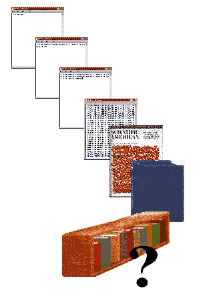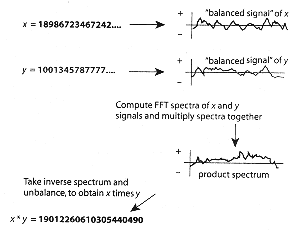| 839405817463524183625410987635241645287364910573829104958253647182928807948372615 |
The Challenge of Large Numbers
|
As computer capabilities increase, mathematicians can better characterize
and manipulate gargantuan figures. Even so, some numbers can only be imagined
Richard E. Crandall
Large numbers have a distinct appeal,a majesty if you will.
In a sense that they lie at the limits of the human imagination which is
why they have long proved elusive,difficult to define,and harder still to
manipulate. In recent decades though computer capabilities have dramatically
improved. Modern machines now possess enough memory and speed to handle quite
impressive figures.For instance it is possible to multiply together million-digit
numbers in a mere fraction of a second. As a result we can now characterize
numbers about which earlier mathematicians could only dream.
Interest in large
numbers dates back to ancient times. We know, for example that the early
Hindus, who developed the decimal system, contemplated them .In the now
commonplace decimal system the position of a digit (1s, 10s, 100s and so
on) denotes its scale. Using this shorthand, the Hindus named many large
numbers; one having 153 digits or as we might say today, a number of of the
order 10153-is mentioned in a myth about Buddha.
The ancient Egyptians, Romans and Greeks pondered large values as well. But
historically, a large number was whatever the prevailing culture deemed it
to be an intrinsically circular definition. The Romans initially had no terms
or symbols for figures above 100,000. And the Greeks usually stopped counting
at a myriad ,word meaning "10,000." Indeed, a popular idea in ancient Greece
was that no number was greater than the total count of sand grains needed
to fill the universe.
In the third century B.C., Greek mathematician
Archimedes sought to correct this belief.
In a letter to King Gelon of Syracuse, he set out to calculate the actual
number of sand grains in the universe. To do so,
Archimedes devised a clever scheme involving
successive ratios that would effectively extend the prevailing Greek number
system, which had no exponential scaling. His results, which in current terms
placed the number somewhere between 1051 to 1063 were
visionary; in fact, a sphere having the radius of Pluto's orbit would contain
on the order of 1051 grains.
Scholars in the 18th and 19th centuries contemplated large numbers that still
have practical scientific relevance. Consider
Avogadro's number; named after the
19th-century Italian chemist Amedeo Avogadro. It is roughly 6.02 x
1023 and represents the number of atoms in 12 grams of pure carbon.
One way to think about Avogadro's number, also called a mole, is as follows:
if just one gram of carbon were expanded to the size of planet Earth, a single
carbon atom would loom something like a bowling ball.
Another interesting way to imagine a mole is to consider the total number
of computer operations-that is, the arithmetic operations occurring within
a computer's circuits - ever performed by all computers in history. Even
a small machine can execute millions of operations per second; mainframes
can do many more. Thus, the total operation count to date, though impossible
to estimate precisely, must be close to a mole. It will undoubtedly have
exceeded that by the year 2000.
Today scientists deal with numbers much larger than the mole. The number
of protons in the known universe, for example, is thought to be about
1080. But the human imagination can press further. It is legendary
that the nine-year-old nephew of mathematician Edward Kasner did coin, in
1938, the googol, as 1 followed by 100 zeroes, or 10100. With
respect to some classes of computational problems, the googol roughly demarcates
the number magnitudes that begin seriously to challenge modern machinery.
Even so, machines can even answer some questions about gargantuan as large
as the mighty googolplex, which is 1 followed by a googol of zeroes, or
1010100. Even if you used a proton for every zero,
you could not scribe the googolplex onto the known universe.
| WAV 257K |
Manipulating the Merely Large
Somewhat above the googol lie numbers that present a sharp challenge to
practitioners of the art of factoring: the art of breaking numbers into their
prime factors, where primes are
themselves divisible only by 1 and themselves. For example, 1,799,257 factors
into 7,001 x 257, but to decompose a sufficiently large number into its prime
factors can be so problematic that computer scientists have harnessed this
difficulty to encrypt data. Indeed, one prevailing
encryption algorithm,
called RSA, transforms the problem
of cracking encrypted messages into that of factoring certain large numbers,
called public keys. (RSA is named after its inventors, Ronald L. Rivest of
the Massachusetts Institute of Technology, Adi Shamir of the Weizmann Institute
of Science in Israel and Leonard M. Adleman of the University of Southern
California.
To demonstrate the strength of RSA, Rivest,Shamir and Adleman challenged
readers of Martin Gardner's column in the August
1977 issue of Scientific American to factor a 129-digit number, dubbed
RSA-129, and find a hidden message. It was not until 1994 that Arjen K. Lenstra
of Beilcore, Paul Leyland of the University of Oxford and then graduate student
Derek Atkins of M.I.T and undergraduate student Michael Graff of Iowa State
University, working; with hundreds of colleagues on the Internet, succeeded.
(The secret encrypted message was "THE MAGIC WORDS ARE SQUEAMISH OSSIFRAGE.")
Current recommendations suggest that RSA encryption keys have at least 230
digits to be secure.
Network collaborations are now common place, and a solid factoring culture
has sprung up. Samuel S. Wagstaff, Jr., of Purdue University maintains a
factoring newsletter listing recent factorizations. And along similar lines,
Chris K. Caldwell of the University of Tennessee at Martin maintains a World
Wide Web site
(http://www.utm.edu/research/primes/largest.html)
for prime number records. Those who practice factoring typically turn to
three powerful algorithms. The Quadratic Sieve (QS) method, pioneered by
Carl Pomerance of the University of Georgia in the 1980s, remains a strong,
general-purpose attack for, factoring numbers somewhat larger than a googol.
(The QS,in fact, conquered RSA-129.) To factor a mystery number,the QS attempts
to factor many smaller, related numbers,generated via a clever sieving process.
These smaller factorizations are combined to yield a factor of the mystery
number .
 |
 LARGE
NUMBERS- such as the 100-digit, or googol-size, ones running across the
tops of these pages - have become more accessible over time thanks to advances
in computing. Archimedes, whose bust appears at the left, had to invent new
mathematics to estimate the number of sand grains required to fill the universe.
His astonishingly accurate result, 1051, was by ancient standards
truly immense. Modern machines, however, routinely handle vastly greater
values. Indeed, any personal computer with the right software can completely
factor a number of order 1051. LARGE
NUMBERS- such as the 100-digit, or googol-size, ones running across the
tops of these pages - have become more accessible over time thanks to advances
in computing. Archimedes, whose bust appears at the left, had to invent new
mathematics to estimate the number of sand grains required to fill the universe.
His astonishingly accurate result, 1051, was by ancient standards
truly immense. Modern machines, however, routinely handle vastly greater
values. Indeed, any personal computer with the right software can completely
factor a number of order 1051. |
A newer strategy, the Number Field Sieve (NFS), toppled a 155
- digit number,the ninth Fermat number, F9 (Named for the great
French theorist Pierre de
Fermat, the nth Fermat number is Fn=
22n + 1.) In 1990 F9 fell to Arien Lenstra,
Hendrik W Lenstra, Jr., of the University of California at Berkeley, Mark
Manasse of Digital Equipment Corporation and British mathematician John Pollard,
again aided by a substantial machine network. This spectacular factorization
depended on F9's special form. But Joseph Buhler of Reed College,
Hendrik Lenstra and Pomerance have since developed a variation of the NFS
for factoring arbitrary numbers. This general NFS can, today, comfortably
factor numbers of 130 digits. In retrospect, RSA-129 could have been factored
in less time this way.
The third common factoring tactic, the Elliptic Curve Method (ECM), developed
by Hendrik Lenstra, can take apart much larger numbers, provided that at
least one of the number's prime factors is sufficiently small. For example,
Richard P. Brent of the Australian National University recently factored
F10 using ECM, after first finding a single prime factor "only"
40 digits long. It is difficult to find factors having more than 40 digits
using ECM. For arbitrary numbers between, say,10150 and
101,000,000, ECM stands as the method of choice, although ECM
cannot be expected to find all factors of such gargantuan numbers.
Even for numbers that truly dwarf the googol, isolated factors can sometimes
be found using a centuries-old sieving method. The idea is to use what is
called modular arithmetic, which keeps the
sizes of numbers under control so that machine memory is not exceeded, and
adroitly scan ("sieve") over trial factors. A decade ago Wufrid Keller of
the University of Hamburg used a sieving technique to find a factor for the
awesome F23471, which has roughly 107,000 decimal digits.
Keller's factor itself has "only" about 7,000 digits. And Robert J. Harley,
then at the California Institute of Technology, turned to sieving to find
a 36-digit factor for the stultifying (googolplex + 1); the factor is
316,912,650, 057,057,350,374,175,801 ,344,000,001.
Algorithmic Advancements
Many modern results on large numbers have depended on algorithms from seemingly
unrelated fields. One example that could fairly be called the workhorse of
all engineering algorithms is the Fast Fourier Transform (FFT). The
FFT is most often thought of as a means for ascertaining some spectrum as
is done in analyzing birdsongs or human voices or in properly tuning an acoustic
auditorium. It turns out that ordinary multiplication,a fundamental operation
between numbers-can be dramatically enhanced via FFT
[see box below]. Arnold Schonage of the
University of Bonn and others refined this astute observation into a rigorous
theory during the 1970s.
FFT multiplication has been used in celebrated calculations of
p to a great many digits. Granted
p is not a bona fide large number; but
to compute p to millions of digits involves
the same kind of arithmetic used in large-number studies. In 1985 R. William
Gosper, Jr., of Symbolics, Inc., in Palo Alto, Calif., computed 17 million
digits of it. A year later David Bailey of the National Aeronautics and Space
Administration Ames Research Center computed
p to more than 29 million digits. More
recently, Bailey and Gregory Chudnovsky of Columbia University reached one
billion digits.
Using Fast Fourier Transforms for Speedy Multiplication |
|
| Ordinary multiplication
is a long-winded process by any account, even for relatively small numbers:
To multiply two numbers, x and y, each having D digits, the usual, "grammar
school" method involves multiplying each successive digit of x by every digit
of y and then adding columnwise, for a total of roughly D2
operations. During the 1970s, mathematicians developed means for hastening
multiplication of two D-digit numbers by way of the Fast Fourier Transform
(FFT). The FFT reduces the number of operations down to the order of D log
D. (For example, for two 1,000-digit numbers, the grammar school method may
take more than 1,000,000 operations, whereas an FFT might take only 50,000
operations.) A full discussion of the FFT algorithm for multiplication is
beyond the scope of this article.In brief, the digits of two numbers, x and
y (actually, the digits in some number base most convenient for the computing
machinery) are thought of as signals. The FFT is applied to each signal in
order to decompose the signal into its spectral components. |
This is done in the same way that a biologist might decompose
a whale song or some other meaningful signal into frequency bands. These
spectra are quickly multiplied together, frequency by frequency.Then an inverse
FFT and some final manipulations are performed to yield the digits of the
product of x and y. There are various, powerful modern enhancements to this
basic FFT multiplication. One such enhancement is to treat the dig it signals
as bipolar, meaning both positive and negative digits are allowed. Another
is to "weight" the signals by first multiplying each one by some other special
signal. These enhancements have enabled mathematicians to discover new prime
numbers and prove that certain numbers are prime or composite (not prime).
- R.E.C.
|
|
|
And Yasumasa Kanada of the University of Tokyo has reported
five billion digits. In case anyone wants to check this at home, the
one-billionth decimal place of p , Kanada
says, is nine.
FFT has also been used to find large prime numbers. Over the past decade
or so, David Slowinski of Cray Research has made a veritable art of discovering
record primes. Slowinski and his co- worker Paul Gage uncovered the prime
21,257,787 - 1 in mid-1996. A few months later, in November;
programmers Joel Armengaud of Paris and George F Woltman of Orlando, Fla.,
working as part of a network project run by Woltman, found an even larger
prime: 21,398,269 - 1. This number; which has over 400,000 decimal
digits, is the largest known prime number as of this writing. It is, like
most other record holders, a so-called
Mersenne prime. These numbers
take the form 2q - 1, where q is an integer, and are named after
the 17th- century French mathematician Marin Mersenne.
For this latest discovery, Woltman optimized an algorithm called an
irrational-base discrete weighted transform, the theory of which I developed
in 1991 with Barry Fagin of Dartmouth College and Joshua Doenias of NeXT
Software in Redwood City, Calif. This method was actually a by-product of
cryptography research at NeXT.
Blaine Garst, Doug Mitchell, Avadis Tevanian, Jr., and I implemented at NeXT
what is one of the strongest-if not the strongest encryption schemes available
today, based on Mersenne primes. This patented scheme, termed Fast Elliptic
Encryption (FEE), uses the algebra of elliptic curves, and it is very fast.
Using, for example, the newfound Armengaud-Woltman prime
21,398,269 - 1 as a basis, the FEE system could readily encrypt
this issue of Scientific American into seeming gibberish. Under current
number- theoretical beliefs about the difficulty of cracking FEE codes, it
would require, without knowing the secret key, all the computing power on
earth more than 1010,000 years to decrypt the gibberish back into
a meaningful magazine.
Just as with factoring problems, proving that a large number is prime is
much more complicated if the number is arbitrary-that is, if it is not of
some special form, as are the Mersenne primes. For primes of certain special
forms, "large" falls somewhere in the range of 21,000,000. But
currently it takes considerable computational effort to prove that a "random"
prime having only a few thousand digits is indeed prime. For example, in
1992 it took several weeks for Francois Morian of the University of Claude
Bernard, using techniques developed jointly with A.O.L. Atkin of the University
of Illinois, and others, to prove by computer that a particular 1,505-digit
number, termed a partition number, is prime.
Colossal Composites
It is quite a hit easier to prove that some number is not prime (that it
is composite, that is, made up of more than one prime factor). In 1992 Doenias,
Christopher Norrie of Amdahl Corporation and I succeeded in proving by machine
that the 22nd Fermat number, 2222 + 1, is composite.
This number has more than one million decimal digits. Almost all the work
to resolve the character of F22 depended on yet another modification
of FFT multiplication. This proof has been called the longest calculation
ever performed for a "one-bit," or yes-no, answer; and it took about
1016 computer operations. That is roughly the same amount that
went into generating the revolutionary Pixar-Disney movie Toy Story,
with its gloriously rendered surfaces and animations.
 |
| COLOSSI become somewhat easier to contemplate-and compare-if one adopts a statistical view. For instance, it would take approximately 103,000,000 years before a parrot, pecking randomly at a keyboard, could reproduce by chance The Hound of the Baskervilles. This time span, though enormous, pales in comparison to the 101033 years that would elapse before fundamental quantum fluctuations might topple a beer can on a level surface. |
Although it is natural to suspect the validity of any
machine proof, there is a happy circumstance connected
with this one. An independent team of Vilmar Trevisan and Joao B. Carvaiho,
working at the Brazilian Supercomputer Center with different machinery and
software (they used, in fact, Bailey's FFT software) and unaware of our completed
proof, also concluded that F22 is composite. Thus, it seems fair
to say, without doubt, that F22 is composite. Moreover
F22 is also now the largest "genuine" composite known-which means
that even though we do not know a single explicit factor for F22
other than itself and 1, we do know that it is not prime.
Just as with Archimedes' sand grains in his time, there will always be colossal
numbers that transcend the prevailing tools. Nevertheless, these numbers
can still be imagined and studied. In particular; it is often helpful to
envision statistical or biological scenarios. For instance, the number 10
to the three-millionth power begins to make some intuitive sense if we ask
how long it would take a laboratory parrot, pecking randomly and tirelessly
at a keyboard, with a talon occasionally pumping the shift key, say, to render
by accident that great detective epic, by Sir Arthur Conan Doyle, The
Hound of the Baskervilles. To witness a perfectly spelled manuscript,
one would expect to watch the bird work for approximately
103,000,000 years. The probable age of the universe is more like
a paltry 1010 years.
How large is large? |
|
 |
To get a better sense of how enormous some
numbers truly are,imagine that the 10-digit number representing the age in
years of the visible universe were a single word on a page. Then the number of protons in the visible universe, about 1080, would look like a sentence. The ninth Fermat number - which has the value Fn=22n+1 (where n is nine) - would take up several lines. The tenth Fermat number would look something like a paragraph of digits. A thousand digit number, pressing the upper limit for primality testing, would look like a page of digits. The largest known prime number,21,398,269-1 in decimal form,would essentially fill an issue of Scientific American. A book could hold all the digits of the 22nd Fermat number, which possesses more than one million digits and is now known to be composite To multiply together two "bookshelves" even on a scalar supercomputer, takes about one minute. 101033 written in decimal form would fill a library much larger than the earth's volume.In fact, there are theoretically important numbers that cannot be written down in this universe,even using exponential notation. |
But 103,000,000 is as nothing compared with the
time needed in other scenarios. Imagine a full beer can, sitting on a level,
steady, rough-surfaced table, suddenly toppling over on its side, an event
made possible by fundamental quantum fluctuations. Indeed, a physicist might
grant that the quantum wave function of the can does extend, ever so slightly,
away from the can so that toppling is not impossible. Calculations show that
one would expect to wait about 101033 years for the
surprise event. Unlikely as the can toppling might be, one can imagine more
staggering odds. What is the probability, for example, that sometime in your
life you will suddenly find yourself standing on planet Mars, reassembled
and at least momentarily alive? Making sweeping assumptions about the reassembly
of living matter, I estimate the odds against this bizarre event to be
101051 to 1. To write these odds in decimal form, you
would need a 1 followed by a zero for every one of Archimedes' sand grains.
To illustrate how unlikely Mars teleportation is, consider that the great
University of Cambridge mathematician John Littlewood once estimated the
odds against a mouse living on the surface of the sun for a week to be
101042 to 1.
These doubly exponentiated numbers pale in comparison to, say, Skewes's number,
10^ (101034), which has actually been used in developing
a theory about the distribution of prime numbers. To show the existence of
certain difficult-to-compute functions, mathematicians have invoked the Ackermann
numbers (named after Wilhelm Ackermann of the Gymnasien in Luedenscheid,
Germany), which compose a rapidly growing sequence that runs: 0, 1,
22, 3^ ( 333)..... The fourth Ackermann
number, involving exponentiated 3's, is approximately
103,638,334,640,024. The fifth one is so large that it could not
be written on a universe-size sheet of paper, even using exponential notation!
Compared with the fifth Ackermann number, the mighty googolplex is but a
spit in the proverbial bucket.

